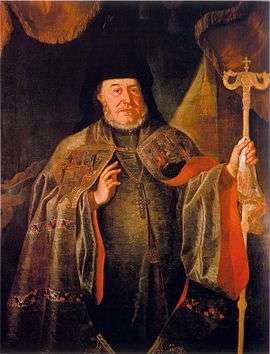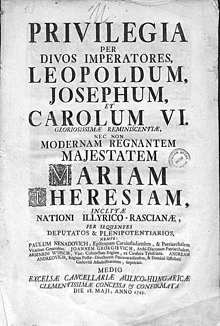Arsenije IV Jovanović Šakabenta
Arsenije IV Jovanović Šakabenta (Serbian Cyrillic: Арсеније IV Јовановић Шакабента, Serbian pronunciation: [ǎrseːnije t͡ʃětʋr̩ːtiː]; 1698 – 18 January 1748) was the Archbishop of Peć and Serbian Patriarch from 1725 to 1737 and Head of the Serbian Orthodox Church in Habsburg Monarchy from 1737 to his death in 1748.[1]
Arsenije IV | |
|---|---|
| Archbishop of Peć and Serbian Patriarch | |
 | |
| Church | Serbian Patriarchate of Peć |
| See | Patriarchal Monastery of Peć |
| Installed | 1725 |
| Term ended | 1748 |
| Predecessor | Mojsije I |
| Successor | Joanikije III |
| Personal details | |
| Born | 1698 Peć, Ottoman Empire |
| Died | 18 January 1748 (aged 50) Sremski Karlovci, Habsburg Monarchy |
He commissioned the Slavic heraldic bearings called Stemmatographia. He opened the first official Academy of Painting on the territory of the Metropolitanate of Karlovci after the artistic and cultural reforms were commenced under the auspices and blessing of Vikentije Jovanović, his predecessor. He was succeeded by Joannicius III of Constantinople.
Biography
Arsenije was born in 1698, and had a younger brother, Andrija, who was a priest and a sister who married knez Atanasije Rašković. Arsenije was consecrated bishop in 1722, a very young age, appointed the Metropolitan of Raška. Arsenije succeeded Serbian Patriarch Mojsije I (s. 1712–1725) upon his retirement due to old age, and was enthroned as Arsenije IV by Mojsije on February 18/29, 1725 in Peć.
Arsenije continued the policies of his predecessors. He traveled extensively and negotiated with the Austrians in order to liberate his people from Ottoman rule. When the Austro-Turkish War (1716–1718) broke out, the Serbs revolted. The Ottomans wanted to capture and kill Patriarch Arsenije IV, but he escaped. After the Austrians were defeated, Arsenije escaped to Austria along with many other refugees. After the peace treaty was signed the Ottomans retained the city of Belgrade, and the territories of what is today Serbia, Montenegro and Macedonia. The Ottoman Porte selected and appointed a new patriarch at the Serbian Patriarchal seat in Peć, the Greek Joannicius, from their trusted Phanariotes.
The Austrian government continued to recognize Arsenije IV as the Serbian Patriarch and gave him administrative authority of the Metropolitanate of Karlovci, the church body of the Habsburg Serbs, a position in which he had difficulties maintaining Serb privileges.
Treaty of Belgrade

With the 1739 Treaty of Belgrade which ended the Austro-Turkish War (1737–1739), the Kingdom of Serbia ceased to exist. The Ottoman sultan deposed the pro-Serbian Patriarch of Peć Arsenije IV and in his place appointed the Greek Joannicius, who took the title of Archbishop of Peć and Patriarch of the Serbs. The entry of Patriarch Arsenije IV Jovanović into Belgrade was symbolic of many things in the minds of simple folk (the transformation of man into an ideal, into an example, etc.). The entry celebrated the long-awaited arrival of Arsenije IV, the Patriarch of Peć, into Belgrade to take up the position of spiritual leader of the Orthodox faithful in Austria.
Arsenije IV commissioned Pavle Nenadović, a clergyman and poet from the town of Karlovci, to compose a heraldic handbook, Stemmatographia (meaning "the drawing of ancestry" in Greek). This heraldic album was modelled after a book of the same title on Slavonic heraldic bearings, engraved in 1701 by Croatian poet Pavao Ritter Vitezović (who modelled his Stemmatographia after an older version of Slavic heraldry composed by Mavro Orbini). Arsenije IV's Stemmatographia was perceived by some as an illustrated political programme that was supposed to act both as a verification of the Serbian historical past and as a clear geo-political statement of the lands belonging to the Serbs in the Balkans. His intention, however, was educational, and for this work he hired three people: Hristofor Zhefarovich originally from Dojran as an artist; German-born Thomas Mesmer as an engraver; and clergyman Pavle Nenadović as a poet. Arsenije IV was well aware of the power of communuication that printed imagery had in those early days of the printing press and the art of engraving. His Stemmatographia was widely distributed among the Serbian villages and towns in the then Habsburg-occupied Serbian lands, and in Imperial Russia where Serbian colonies existed. (The letter from Arsenije IV, written and dated 19 June 1743, demanding a wide distribution is kept in the Archiepiscopal Archives Sremski Karlovci under the presswork B-1743-68).
The previous Patriarch Arsenije IV moved north to the Habsburg Monarchy along with many Serbs, in what is known as the Second Serbian Migration. Arsenije IV became Metropolitan of Karlovci, maintaining however deep connections with the Serbs who remained in the Ottoman Empire, particularly the Kosovo Vilayet, now under the Phanariote jurisdiction of Joannicius. Joannicius remained Patriarch of Peć until 1746, when, burdened with debts due to his high-living, he was forced to sell the title to pay his creditors.[2] He was succeeded by Atanasije II (Gavrilović).
Academy of Painting
The artistic and cultural reforms commenced in Sremski Karlovci under the auspices and blessing of Metropolitan Vikentije Jovanović, was reinforced under his successor, Arsenije IV Jovanović Šakabenta, who opened the first official Academy of Painting at his court in the Metropolitanate of Karlovci, and put the entire production of religious art under the firm control of the Serbian Orthodox Church. In 1743 he made an official proclamation in which he invited all those interested in the fine arts to join his Academy of Painting at Karlovci. For that purpose he invited two painters, Jov Vasilijevič and Vasilije Romanovič, from Kiev to join the teaching staff at the school. The inauguration of the Academy of Painting in Karlovci would mark the beginning of a new style and artistic idiom, and even more significantly, a novel understanding of the sacred images and its functions.
Title
Arsenije signed himself "Arsenije, By the Grace of God, Archbishop of Peć and Patriarch of all Serbs and Bulgarians and all of Illyria".[3] Another style was "Archbishop of All Serbs, Bulgarians, Western Pomorje, Dalmatia, Bosnia, both halves of Danube and all of Illyria".[4]
See also
- Great Serb Migrations
- Metropolitanate of Karlovci
- List of heads of the Serbian Orthodox Church
References
- Вуковић 1996, p. 33-34.
- R. Aubert (2000). "Joannikios III". Dictionnaire d'histoire et de géographie ecclésiastiques. 27. Paris: Letouzey et Ané. 1379-80. ISBN 2-7063-0210-0.
- Srpska akademija nauka i umetnosti (1950). Posebna izdanja.
Док се Арсеније у својим писмима обично потписује „Арсеније божиеју милостију архиепископ пекски и всем Србљем и Блгаром и всего Илирика патриарх' (Јов. Радонић, Прилози за историју Срба у Угарској (Нови Сад 1909), 138) ...
- Recherches sur l'art. 26. Matica. 1990. p. 284.
У првом наслову кььиге сто]и да ]е патриарх Арсен^е IV архиепископ свих Срба, Бугара, западног Помор]а, Далмаци ю, Боене, обе половине Дунава и целог Илирика. То ]е поновлено и испод патри)арховог портрета и испод ...
Sources
- Bataković, Dušan T., ed. (2005). Histoire du peuple serbe [History of the Serbian People] (in French). Lausanne: L’Age d’Homme.CS1 maint: ref=harv (link)
- Ćirković, Sima (2004). The Serbs. Malden: Blackwell Publishing.CS1 maint: ref=harv (link)
- Đorđević, Miloš Z. (2010). "A Background to Serbian Culture and Education in the First Half of the 18th Century according to Serbian Historiographical Sources". Empires and Peninsulas: Southeastern Europe between Karlowitz and the Peace of Adrianople, 1699–1829. Berlin: LIT Verlag. pp. 125–131.CS1 maint: ref=harv (link)
- Fotić, Aleksandar (2008). "Serbian Orthodox Church". Encyclopedia of the Ottoman Empire. New York: Infobase Publishing. pp. 519–520.CS1 maint: ref=harv (link)
- Kašić, Dušan, ed. (1965). Serbian Orthodox Church: Its past and present. 1. Belgrade: Serbian Orthodox Church.CS1 maint: ref=harv (link)
- Pavlovich, Paul (1989). The History of the Serbian Orthodox Church. Serbian Heritage Books.CS1 maint: ref=harv (link)
- Dušan Popov, Karlovačka mitropolija, Enciklopedija Novog Sada, sveska 10, Novi Sad, 1998.
- Слијепчевић, Ђоко М. (1962). Историја Српске православне цркве (History of the Serbian Orthodox Church). књ. 1. Минхен: Искра.CS1 maint: ref=harv (link)
- Todorović, Jelena (2006). An Orthodox Festival Book in the Habsburg Empire: Zaharija Orfelin's Festive Greeting to Mojsej Putnik (1757). Aldershot: Ashgate Publishing.CS1 maint: ref=harv (link)
- Вуковић, Сава (1996). Српски јерарси од деветог до двадесетог века (Serbian Hierarchs from the 9th to the 20th Century). Београд: Евро.CS1 maint: ref=harv (link)
External links
| Eastern Orthodox Church titles | ||
|---|---|---|
| Preceded by Mojsije I |
Serbian Patriarch 1725–1737 (1748) |
Succeeded by Joanikije III |
| Preceded by Vićentije II |
Metropolitan of Karlovci 1737–1748 |
Succeeded by Isaija II |